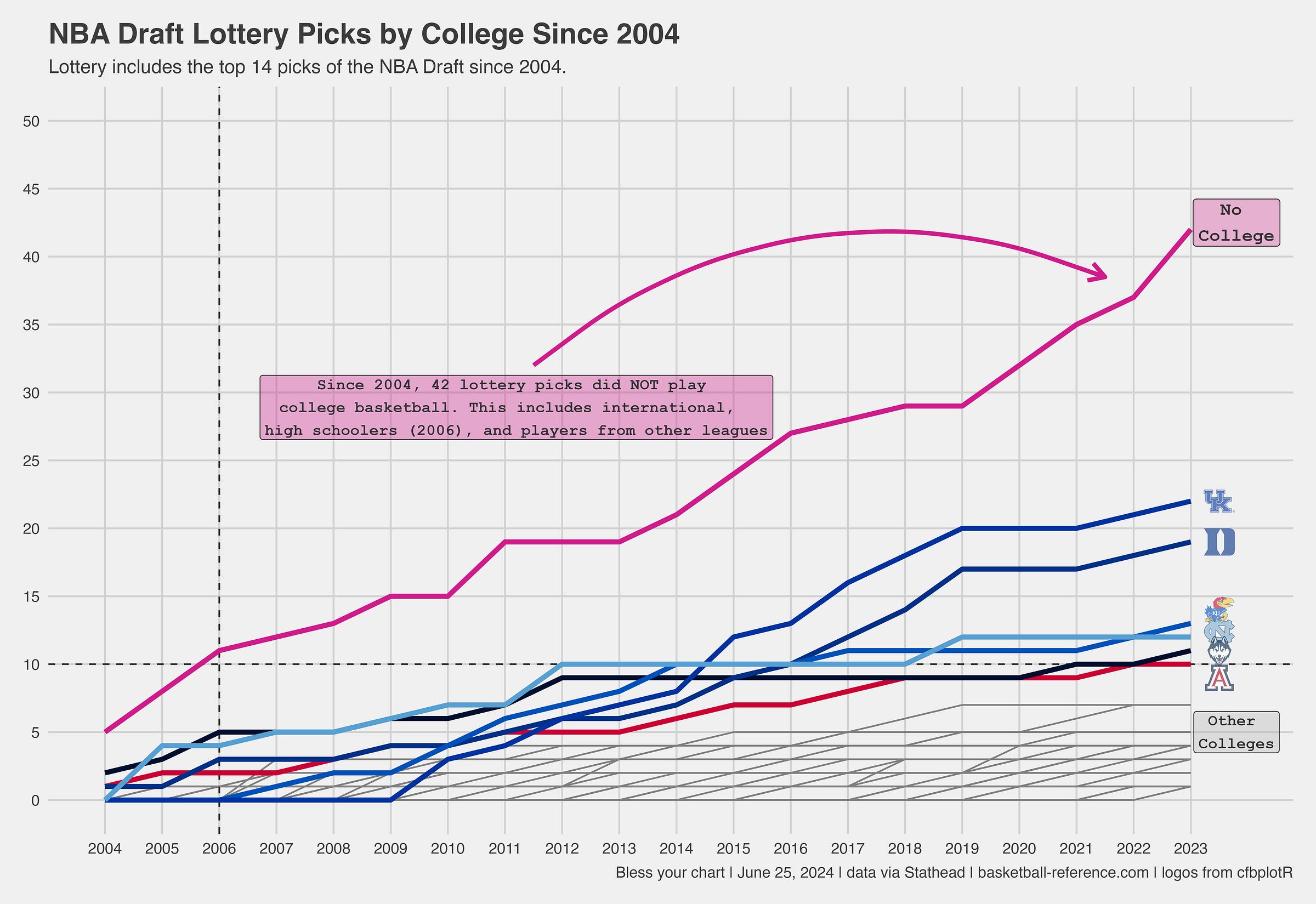098: NBA Lottery Picks Since 2004
A look at how many lottery picks never played college basketball.
The 2024 NBA Draft is the first time the league is holding the event over two days. The first round starts tomorrow, June 26, at 8 pm ET and the second round begins at 4 pm ET on Thursday.
Why does the hype around the event feel muted compared to previous years?
Maybe it’s due to spanning two days, the perception that this draft class is weak, or maybe I’m just getting older1.
The more I think about it, my assumption is it’s because most of us don’t have familiarity with the players. Not the players selected in the late second round, it’s more those players selected towards the top of the draft.
Since the 2004 NBA Draft, the lottery has featured 14 teams. A lottery pick is known as the top 14 picks in this time frame. That’s 280 picks over the last 20 drafts.
42 of those 280 picks, or 15 percent, never played college basketball. This number is greater than the combined total of lottery picks produced by the top two college teams, Kentucky and Duke, over the same period.
Below is a chart showing the number of lottery picks by college since 2004, including those players that did not play collegiate basketball, using data from Stathead Basketball. This is an arbitrary cutoff, so keep that in mind.
A few notes on the highlighted collegiate teams2 or teams with at least 10 or more lottery picks over the past 20 drafts.
No College: 42 total players, includes players like Dwight Howard (straight from high school in 2004), Luka Dončić (international in 2018), and LaMelo Ball (other league in 2020).
Kentucky: 22 players, all from 2010 draft and beyond, and none from 2004 to 2009. This includes players from John Wall to Devin Booker.
Duke: 19 players, includes Shelden Williams and a recent NBA Champion (Jayson Tatum).
Kansas: 13 players from Brandon Rush in 2008 to Gradey Dick (2003).
North Carolina: 12 players, and none since 2019. The 2022 runner up team had zero players drafted that year, which sort of explains the current state of college basketball.
UConn: 11 players, and this is sure to change after tonight’s draft. Ben Gordon to Kemba Walker to Jeremy Lamb, the Huskies have produced some high draft picks.
Arizona: 10 players, remember Jerryd Bayless and Stanley Johnson?
The NBA Draft produces some incredible data work that is done in public. A lot of Americans can bet on the draft now, and that provides some element of entertainment too. Of course, trades happen and NBA free agency is a spectacle we all enjoy.
To me, the NBA Draft is a reminder that college basketball and the NBA are becoming more and more radically different. And that’s not necessarily a good or bad thing, it’s just different.
Thanks for reading this far. You can find the code for this chart here, and check out Stathead if you haven’t done so already.
As we head into a month without any college sports, I might be publishing less frequently and exploring a few random projects. Some ideas include: fun with college basketball referee data, consequences of expanding the NCAA basketball tournament3, and college football win totals.
Stay tuned, subscribe if you so choose, and enjoy the NBA Draft.
Pearlman’s tweet is more or less why I decided to look up some NBA Draft data. Pearlman has written some fascinating books, I read Three Ring Circus during the pandemic. This anecdote from J.R. Reid about Kobe Bryant always stuck with me.
These teams have won 13 of the last 19 NCAA titles (UConn: 2004, 2011, 2023, 2024), North Carolina (2005, 2009, 2017), Duke (2010, 2015), Kansas (2008, 2022), and Kentucky (2012).
What happens to conference tournaments? You can make a case conference tournaments mean too much for small leagues and too little for big leagues. Expansion of the big dance feels inevitable, and I’ve yet to see a league rethink its conference basketball tourney.




